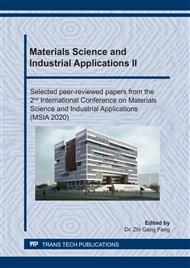[1]
Zhong S, Chen Z. Properties of latex blends and its modified cement mortars[J]. Cement and Concrete Research, 2002,32(10):1515-1524.
DOI: 10.1016/s0008-8846(02)00813-x
Google Scholar
[2]
Zhong Shiyun, Tan Muhua, Chen Zhiyuan. Chloride ion permeability of styrene-acrylic emulsion modified cement mortar [J]. Journal of Building Materials, 2002,5 (4): 393-398.
Google Scholar
[3]
Maslehuddin M, Al-Dulaijan S U, Al-Zahrani M M. Mechanical properties and durability characteristics of polymer- and cement-based repair materials[J]. Cement & concrete composites, 2003,25(4/5):527-537.
DOI: 10.1016/s0958-9465(02)00092-6
Google Scholar
[4]
Wu Keru, Li Shujin. Mechanical behavior of hybrid steel fiber cement-based materials [J]. Journal of Tongji University (Natural Science), 2006,34 (8): 1075-1078.
Google Scholar
[5]
Li Shujin, Wu Keru. Study on Fracture Properties of Geometric Hybrid Steel Fiber Cement-based Materials [J]. Journal of Changzhou Institute of Technology, 2006,19 (4): 19-22.
Google Scholar
[6]
Meng Wei, Deng Yunfei, Sun Qiang. Effect of Steel Fiber on Mechanical Properties of Polymer Cement Mortar [J]. Journal of Huaihai Institute of Technology (Natural Science Edition), 2014 (01): 50-53.
Google Scholar
[7]
Deng Yunfei, Jin Lingzhi, He Lai, et al. Experimental study on mechanical properties of steel fiber polymer cement mortar [J]. Journal of Jinggangshan University (Natural Science Edition), 2016 (06): 65-70.
Google Scholar
[8]
Ruan Shaoqin, Xu Fang, Tang Yong, et al. Effect of polypropylene fiber and styrene-butadiene emulsion on mechanical properties of rubber mortar [J]. Concrete, 2014 (01): 121-123.
Google Scholar
[9]
Yuan Zongzheng, Xu Fang, Liu Miao, et al. Study on Mechanical Properties of Modified Cement Mortar Mixed with Organic Fiber and Polymer [J]. Materials Review, 2015 (18): 108-112.
Google Scholar
[10]
Zhao Lijie, Li Chongzhi, Zhang Yinxiang. Effect of Compound Polymer and Fiber on Mortar Performance [J]. Journal of Henan University of Science & Technology (Natural Science), 2013,34 (04): 70-74.
Google Scholar
[11]
NGUYEN Van-Tuan, Li Guhua, Liu Tongchao, et al. Calculating the direction effective coefficient of two-dimensional steel fiber concrete based on probability theory [J]. Modern Tunnel Technology, 2019,56 (2): 119-122.
Google Scholar
[12]
Yao Yan, Ye Liansheng, Qian Huiyan. Effective coefficient of post-crack fiber of random short fiber reinforced concrete [J]. Journal of Nanjing Institute of Technology, 1983 (01): 87-95.
Google Scholar


